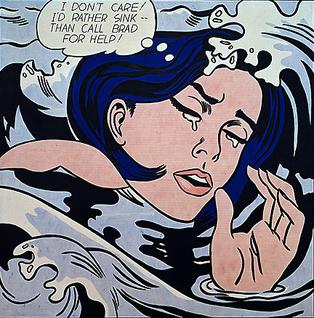
Drowning Girl by Roy Lichtenstein, 1963. Roy Lichtenstein used the splash page of a romance story in DC Comics' Secret Hearts #83 (November 1962), lettered by Ira Schnapp, as the basis for the image.
To most students citation is a familiar term. When students writing a paper want to include a passage from another source, they copy, paste, and attribute the passage. Also students are expected to quote just the necessary amount to support their case.
But do students in studio art and multimedia production classes have a similar obligation to cite works or minimize use of copyrighted works when creating pieces of art, film, or video? And what guidelines should an instructor follow when a student wishes to appropriate imagery, video, and/or sound into their works?
The same fair use guidelines allowing writers to incorporate and cite others works can be applied in the studio art and media production classroom. The tricky part is that audio-visual media often seems to have a higher standard of fair use as there are many examples of aggressive legal action against alleged fair users: example 1, example 2, example 3.
Fair use gives a student the opportunity for creative expression without being hindered in the process, trying to obtain permission for a work. When creating some form of content students are often inspired by existing work. Many times students seek to incorporate portions of the existing work (audio, image, video, etc) into original pieces, but was it done in the spirit of transforming the work such that we are not just using it for the same purpose. And if not “transformational,” does this use by the student amount to a form of plagiarism.
The Center for Social Media, part of American University’s School of Communication, sets guidelines for documentary filmmakers in their “Best Practices in Fair Use.” This document provides two guiding principles of fair use that I believe can be used in an educational context when teaching courses where students are using multimedia to make creative projects.
[youtube]http://www.youtube.com/watch?v=CJn_jC4FNDo[/youtube]First the Center asks, “Did the unlicensed use “transform” the material taken from the copyrighted work by using it for a different purpose than the original, or did it just repeat the work for the same intent and value as the original?” Based on this principle the idea is to encourage students to judge whether they are achieving a meaningful level of reinterpretation of the material or simply reusing it. Is the material employed “as the object of social, political, or cultural critique?” Is the material used to illustrate an argument or point? Also it should be emphasized to students that using a variety of digital tools (filters, effects, etc.) to transform material is not necessarily transformation from a fair use perspective.
The second principle asks, “was the amount and nature of material taken appropriate in light of the nature of the copyrighted work and of the use?” In other words, did you use more of the copyrighted work than was necessary? “The use should not be so extensive or pervasive that it ceases to function as critique and becomes, instead, a way of satisfying the audience’s taste for the thing.” A students’ goal when employing outside material should be to use what is minimally necessary to frame the commentary or to illustrate the point.

Associated Press The original photograph of Barack Obama, top, and Shepard Fairey’s “Hope” poster.
Some of my favorite examples in art in include Pop Art, Subvertising, and Video Mash-ups. You can wonder if Andy Warhol would have been able to succeed as an artist today likely having to combat an endless number of lawsuits. And of note, Shepard Fairey is being sued by the AP for “misappropriating” an image of Barack Obama to create the now famous “Hope” poster. The case is still ongoing, and should be watched.
Finally, one of the best ways to avoid issues of fair use is not incorporate copyrighted works at all. In the image saturated world we live in now, it’s hard to not be tempted to use and reuse media. And sometimes it seems practically impossible to take a photograph and/or shoot video without capturing copyrighted media content. But by still encouraging students to go out and generate original material through drawing, painting, 3D modeling, taping, shooting, etc. is the best piece of “fair use” advice.











Know Your Meme has a great way to argue Fair Use via YouTube. I think it’s great that YouTube has this feature built in… even though it’s pretty complicated.
Thanks Maura. I’ll definitely have my students check out these sites too.
Great post Michael! I’ve found the Center for Social Media’s guide to be really useful in my work with students.
Another option is to encourage students to use Creative Commons licensed images, audio and video rather than copyrighted work where possible. There’s a great page of CC resources on the wiki here at the Academic Commons, and a handy search on the CC website as well: http://search.creativecommons.org
Another interesting look. One that I think our students might share.
Great post Michael.
What an entertaining and informative video!